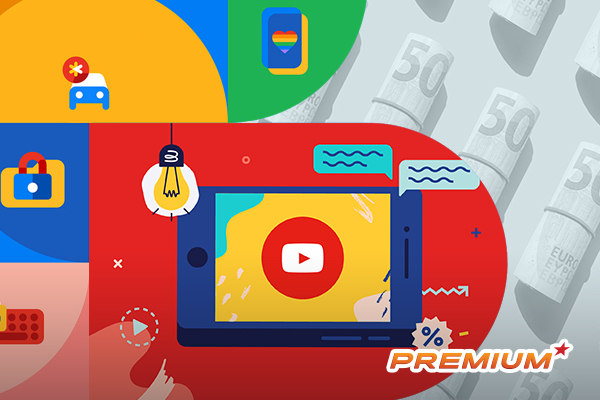Born from a major restructuring in 2015, Alphabet is basically Google’s parent company, contributing almost all of its revenue and profits. Google always describes itself as a technology company and invests in many areas such as Internet search, mobile, artificial intelligence, self-driving cars, medical technology. Still, Google’s main business is online advertising. In 2020, Alphabet recorded $183 billion in revenue, of which $147 billion — more than 80% — came from the advertising division.
Google has been the market leader in online advertising for more than a decade and is expected to capture nearly 29% of digital ad spend by 2021, according to research firm eMarkerter. Over the years, Google built and acquired a number of advertising tools, allowing ad buyers to find the type of audience they were targeting across Google Search, YouTube, Maps, and other websites. While Search and other properties still make up the bulk of Google’s ad revenue, YouTube’s ad business — which grew by 50 percent in the first quarter — is increasingly in competition with traditional TV ads.

Search and other Google properties
Search is the most profitable part of Google. In 2020, the company generated $104 billion in revenue from “search and other activities,” accounting for 71% of Google’s ad revenue and 57% of Alphabet’s total revenue.
The “search and other activity” metric includes revenue generated from Google’s search properties, along with advertising on other Google-owned products such as Gmail, Maps, and Google Play. Advertisers using Google products can bid on search keywords, which are specific words/phrases so that their ads appear in front of target users in search results.
Each advertiser is selected from a variety of auction strategies. If they want to drive more traffic to their website, they can choose to set “cost-per-click” (CPC – cost-per-click) bidding to pay based on each time someone clicks on their ad. They will set a maximum cost-per-click (maximum CPC) bid. According to digital marketing expert Joe Balestrino, the more competitive and expansive an industry is, the more expensive the bids will be.
“For example, if you are a lawyer and deal with crane accidents… You want to make millions of dollars in a lawsuit, then you can spend hundreds of dollars per click. If you’re running a house cleaning service, you might pay as little as $7 per click because the average cost is just $50. So, depending on the niche and how much a business owner wants to earn, the prices for keywords also vary,” he explains.
Google also allows advertisers to target location, language, or audience. For example, people interested in buying financial products or services or people renting/renting a house.
Google primarily shows ads on commercial searches, which means about 80% of searches don’t generate any income through advertising. However, as shopping trends tend to move more online, analysts predict advertising budgets will also shift from TV and direct marketing to search.
Meanwhile, products like Maps are increasingly important in terms of advertising. Using Google maps, advertisers can purchase ads for “pinned” locations and local business listings. The new ad-enabled map from 2019, has over 1 billion monthly active users. Maps are one of Google’s most untapped products, according to some experts. Morgan Stanley analyst Brian Nowak predicts Maps ads to be worth $11 billion by 2023.
YouTube
According to the 2020 business report, YouTube contributes the least of Google’s three largest advertising revenue streams, bringing in nearly $20 billion in revenue, or 13%. But YouTube is growing faster than any of its other advertising revenue streams.
If YouTube authors want to monetize their channel and are eligible, they can enable video ads and share the ad revenue with Google. Conversely, YouTube also runs ads on videos from channels that aren’t on the partner program list.
Authors can also make money in other ways like installing members on their channel, selling merchandise, or getting a commission when YouTube Premium members watch their videos.
A marketer looking to buy ads on YouTube has many options, including skippable/non-skippable in-stream ads, video discovery ads, bumper ads, out-stream ads, top-of-page ads owner.
Over the past months, YouTube has announced several experimental features that not only identify products in videos, but also list those items. The algorithm that suggests related videos when the user scrolls the mouse is also a potential monetization tool. Myles Younger, senior director of research firm MightyHive, said that, despite its growth, YouTube is like a sleeping giant inside the Google ecosystem. Advertisers love videos, especially if they buy them automatically with data at a larger scale.
Google Network and advertising technology for publishers
The third leg of Google’s advertising revenue is the Google Network, which contributes $23 billion in revenue in 2020. It includes revenue arising from advertising sales outside of Google. In other words, publishers or application developers can use Google’s platforms such as AdSense, Google Ad Manager, AdMob to provide ad slots to advertisers. Publishers and Google split the revenue in different proportions, depending on the work of each.
Today, more than 2 million content publishers are AdSense customers. They will enter the Google code on the website or video, and then the advertiser bids to buy the ad. If a publisher’s content displays ads through AdSense, they will receive 68% of the revenue that Google recognizes associated with the service. They can also place search ads on a website or app to earn revenue when readers click, then get 51% of the revenue from AdSense for search.
In addition, Google owns a number of other products for all kinds of audiences in the online advertising market. These include Google Ads, a platform that helps advertisers run search, display, video, app, shopping and local ads at minimal cost; Google Marketing Platform for big advertisers, with analytics tools for small businesses.
With the relentless investment in ad technology, Google’s position in the market seems unlikely to change overnight.